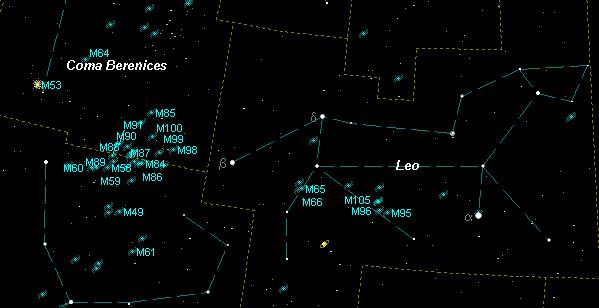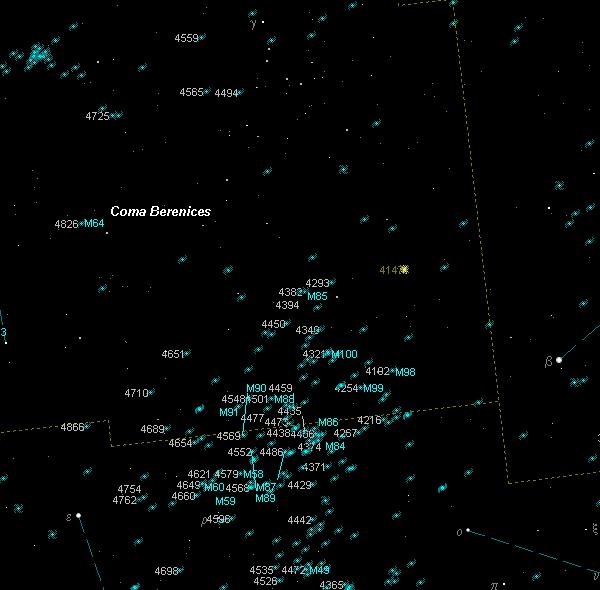The Leo/Virgo/Coma Galaxy Fest
If you took part in the Messier Marathon this past March, you no doubt had to negotiate the swarm of galaxies in Virgo, Leo and Coma Berenices. Many of these objects do not reside near reference stars, thus making the hunt even more challenging.
But now that the rush is over and the dust has settled, we have time to search for these and other remote objects. This is also a perfect time of year weather-wise. As winter’s snows are now a thing of the past, spring nights are quite enjoyable before the hum of mosquitoes drives us indoors.
Before attacking the Virgo Cluster, I like to warm up with a few brighter galaxies in Leo. Even here, nestled in the Lion, galaxies come in groups that fit nicely in wide-angle eyepieces. The first stop is the trio of M65, M66 and NGC 3628 aka the Leo Triplett. With magnitude brightness of 9.3, 9.0 and 9.5 respectively, NGC 3628 is larger in size; however, it is a bit dimmer and a little more challenging edge-on galaxy to spot. The group is estimated to be 35 million light-years (ly) from us.

Now continuing some five and a half degrees south brings to the bright planet Saturn. Its rings are slowly but surely tilting to the ring plane lineup in September of this year. Even though we cannot distinguish the gorgeous rings, we can easily identify the few Saturnian’s moons. A large scope can spot seven orbiting moons.
Another interesting galaxy group residing halfway between the previously mentioned Leo Trio and Regulus consists of M95, M96 and M105. M96 is the dominant member and is estimated to be 38 million ly away. M96 does possess one detailed arm. Its counterpart, M95 has a somewhat bar protruding through the core and has a nice arm structure.
Now for some hunting in Virgo. First, locate Beta Leo otherwise known as Denebola. Now move your scope about six and a half degrees to the east till you pick up a lot of faint fuzzies. You should come across M84. This giant elliptical galaxy lists as 60 million ly from us and are one of the brightest galaxies in the area. M84 also states the end of Markarian’s Chain of galaxies. This line of remote galaxies is a sight to see. More than a dozen galaxies make up the chain with M84, M86 and M91 being the only Messiers.
While still Virgo the lovely pair of NGC 4567 and NGC 4568 is best referred to as The Siamese Twins. As illustrated, they are interacting with each other to form a stunning view. NGC 4567 measure 3.1 arc minutes long and is magnitude 11.3. On the flip side, NGC 4568 is a bit larger and brighter at magnitude 10.9 and measures 4.6 are minutes. The two show detail in their arms.
NGC 4762 is a very interesting edge-on galaxy measuring 8.7 by 1.7 arc minutes. What sets this galaxy apart from the rest is its end to end uniform brightness. Galactic brightness is usually concentrated in the middle. A mere 10 arc minutes northwest of 4762 is NGC 4754. Its dimensions are 4.4 by 2.4 arc minutes and has a somewhat roundish structure to it. The two make an impressive image.
For a bit of a challenge, might I suggest NGC 4780? It is small at 1.8 by 1.5 arc minutes as well as faint at magnitude 14.8 but if you can spot it and image it, your efforts will be rewarded. NGC 4780 has some lovely galactic structure to it.
Moving across the border and venture into Coma Berenices. M64 is a must-see for your observing list. Dubbed the Black Eye or Sleeping Beauty Galaxy, evidence of darker dust is seen in any sized telescope. M64 is 40,000 ly wide and seems to be about 20 million ly from us. This galaxy possesses some fine detail especially when imaged.
For a change of pace, lets us look at something in our Milky Way Galaxy. The only globular cluster residing within this constellation’s borders is M53. Discovered by Johann Bode in 1775, this globular is one of the farthest from the galactic center. It lies some 60,000 years, almost at our galaxy’s edge. It is a bulky object, estimated to be 220 ly in width. At magnitude 7.6 it is fairly bright for its distance.
Of course, one of the best examples of a dusty edge-on galaxy is NGC 4565. Long and slinky, it measures 12.1 by 2.1 arc minutes. Many Canadian astrophotographers have captured the subtle detail of this gem. Some 31 million ly separate us and NGC 4565 which glows at magnitude 9.7.

Mercury just underwent greatest eastern elongation on April 30th but will still be glimpsed low in western skies close to the Pleiades after sunset. Speaking of planets, Saturn is setting around 4 a.m. at the beginning of May. Meanwhile, brilliant Jupiter is up in the east around 2:30 a.m. local time while Venus and Mars clear the eastern horizon around 4:30 a.m.
Be sure to check out Jupiter on the morning of the 25th as it will be a mere 24 arc minutes (less than the full moon) southwest of Neptune. If you have never taken at the now furthest planet of the solar system, now is the time.
Till next month, clear skies everyone
